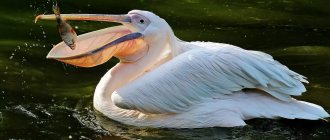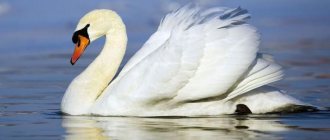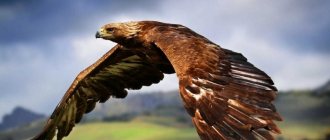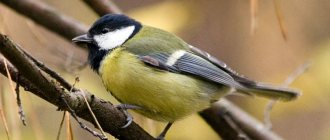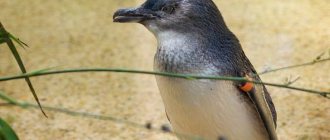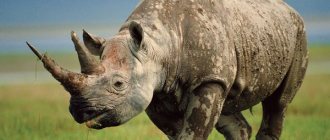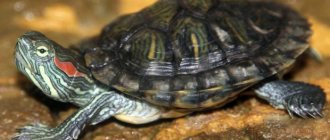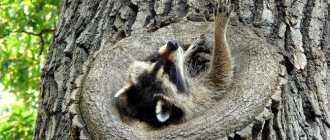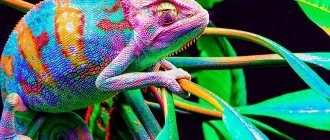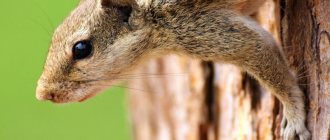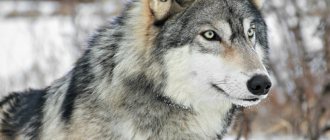- Wild animals
- >>
- Birds
Among the huge number of birds inhabiting our planet, it is impossible to ignore a truly royal person - the mysterious and amazingly beautiful flamingo . As soon as we pronounce this name, a bright image appears before our eyes, a symbol of grace and elegance. But the main thing we know about these creatures is the unique color of their plumage. In adults, it varies depending on the species - from pale pink to almost scarlet.
Origin of the species and description
Photo: Flamingo
The history of the origin of these representatives of the earth's fauna goes back more than 30 million years. The homeland of the ancestors of modern flamingos is considered to be areas with a warm, even hot climate - Asia and Africa. However, the geography of their fossilized remains also covers areas of South and North America and Europe.
Thanks to their natural beauty, grace and amazing color, flamingos have long been admired by people, become heroes of legends and are endowed with supernatural properties. The ancient Egyptians revered these birds as sacred birds, worshiped them, brought gifts and dreamed of the fulfillment of desires, believing in their miraculous power. And, by the way, they were considered “birds of dawn”, and not at all “sunset”, as the famous song says.
Video: Flamingo
The name “flamingo” itself is derived from the Latin word “flamma”, which means “fire”. This consonance allowed people to believe that the mythical phoenix bird, burning and being reborn from the ashes, found its real embodiment in a proud representative of the genus of birds with “fiery” plumage.
However, in reality everything looks much more prosaic. In appearance, flamingos are similar to representatives of the long-legged cranes or herons, but are not officially related to them.
Interesting fact: flamingos' closest relatives are geese.
Yes exactly. Classifiers of wildlife classified flamingos in the order Anseriformes until specialists identified a special order for them - flamingiformes.
Flamingo: description
In fact, the appearance of this bird is quite remarkable and is distinguished by the presence of a massive body, which is supported by relatively high legs. The neck is also high, at the end of which there is a small head with a characteristic curved beak. The pink color of the plumage attracts special attention. The flamingo family includes 4 species, represented by 3 genera, although some scientists believe that there are actually 5 species of flamingos.
The oldest remains of these birds were discovered in Great Britain. Lesser flamingos represent the smallest birds of this family. They weigh no more than 2 kilograms and reach a height of about 1 meter. Common flamingos are considered the most common. They gain weight to almost 5 kilograms and reach a height of one and a half meters.
Appearance
It is not only long-legged, but also a long-necked bird, while it has a small head and a relatively large, downward-curved beak. The peculiarity is that in flamingos the mandible is mobile, and not the mandible, as in many birds. At the edges of the beak there are horny plates with teeth, which help the bird to filter everything that enters the mouth in order to obtain food items.
Interesting moment! The flamingo's neck, in proportion to its body, is thinner and longer than the swan's neck. Because of this, the bird often gets tired and throws it behind its back to relax its neck muscles.
The upper part of the fleshy tongue also contains horny plates. The bird's plumage extends to the upper part of the lower leg, while the length of the tarsus, compared to the lower leg, is 3 times longer. The front toes are equipped with well-developed swimming membranes. The size of the rear toe is so small that it appears as if it is missing. The nature of the plumage is not considered dense, but it is quite soft. Feathering is also missing around the eyes, chin and bridle. The wings are not too large, but wide, with a black border, although not always.
The tail is quite short and consists of one and a half dozen tail feathers, with the middle pair of feathers being the longest. Some species do not have a characteristic red coloration, so their colors are more off-white or gray.
The color of these birds depends on the presence of lipochromes, which are coloring pigments. As a rule, they enter the body of flamingos along with food. The bird molts for 1 month, during which time it loses some of the feathers that form its wings and becomes partially vulnerable, as it cannot fully fly.
Appearance and features
Photo: Flamingo bird
The appearance of any representative of the animal world is determined, as a rule, by the characteristics of the lifestyle and habitat. Flamingos are no exception.
Nature has endowed these birds with everything necessary for a comfortable existence in familiar conditions:
- Long strong legs for moving through shallow water;
- Long neck for easy search for food;
- Webbed feet so as not to get stuck in the muddy bottom of reservoirs;
- A strong, curved beak with serrated edges for straining food;
- Wings for flying to warmer regions and places of food.
Flamingo is a wetland dweller. Weighs on average 3.5-4.5 kg, but there are both larger and smaller individuals. Height - approximately 90-120 cm. The body is rounded, ending in a short tail. It bears the well-deserved title of the longest-legged and longest-necked bird on the planet (in relation to the size of the body).
Interesting fact: a flamingo's neck is normally curved, but if it is stretched into a straight line, it will be equal to the length of its legs.
Flamingos have small wings. To get into the air, he has to take a long run, and to keep his body in flight, he has to flap his wings quite often and actively. In flight, the bird does not bend its neck and legs, but extends them in one line. It flies quickly, smoothly and gracefully.
The plumage of flamingos is white, pink or scarlet. Interestingly, all representatives of this species are born white. The saturation of the color of the feathers depends on the diet, namely, on the amount of carotene contained in the food consumed. The more it is, the more actively the flamingo’s body produces the pigment astaxanthin, and the brighter its color becomes.
Interesting fact: unlike most feathered representatives of the earth's fauna, females and males of flamingos are colored the same.
The order includes the following species of flamingoformes:
- Pink (regular);
- Red (Caribbean);
- James's Flamingo;
- Chilean;
- Andean;
- Small.
The largest representative of the species is the pink (common) flamingo. Its weight is more than 4 kg, and its height reaches 140 cm. And the small flamingo is obviously the smallest of the flamingoformes order. It weighs almost half as much as its pink (ordinary) counterpart and hardly grows above 90 cm.
What does a flamingo look like?
Flamingo looks very graceful. This large waterfowl has thin, long legs and a flexible neck, and the flamingo's unusual coloring has never gone unnoticed. Adult males and females of the common flamingo have soft pink plumage. The wings of the flamingo bird are purple-red, with black flight feathers. The slender legs of flamingos have a pinkish tint. The beak is also pink but has a black tip.
The flamingo looks unusual not only due to the unique coloring of its plumage. The flamingo bird holds its long neck in the shape of a question mark with enviable grace. Flamingos can also easily stand on one leg. To reduce heat loss, they take turns holding their legs in their plumage. From the outside, this position seems very difficult and uncomfortable. But in reality it requires absolutely no effort from the flamingo.
The flamingo bird has a massive beak curved downward. In flamingos, the movable part of the beak is the upper part, not the lower part, which distinguishes it from many other birds. On the head of the common flamingo there are areas not covered with feathers - the frenulum and a small ring around the eyes, which are red. The pink flamingo has a round body and a very short tail.
The flamingo looks like a fairly large bird. The total body length is 120-130 cm. The weight of adult individuals reaches 3.5-4 kg. They have 4 toes on their feet, 3 of which are connected by a swimming membrane.
Why are flamingos pink? The pink color of flamingo plumage is given by the substance carotene, which birds receive along with food. Flamingos owe their pink color to small red crustaceans that contain the same carotene.
In zoos, flamingos do not lose their unique coloring, since foods with carotene are added to their diet: carrots and bell peppers, and, of course, small crustaceans. Due to this, the flamingo looks as bright as in the wild.
Where do flamingos live?
Photo: Pink flamingo
Flamingos do not live alone. They gather in huge groups, called colonies, and occupy convenient territories along the banks of small reservoirs or lagoons. They are thermophilic and prefer to settle in places where there is enough food and there is no need to make long flights in search of food.
Interesting fact: some flamingo colonies number more than 100 thousand individuals.
The largest concentration of these birds, as before, as millions of years ago, is observed in the Southeast and Central regions of Asia and Africa. However, flamingos have chosen many other territories suitable for their comfortable existence.
For example, the pink (common) flamingo nests in the southern regions of Spain and France, India and Kazakhstan. This is the only species that makes long flights, and during migrations it can deviate quite significantly from the route, ending up in the northern regions - near St. Petersburg or on Lake Baikal.
Very similar to the common flamingo, the Chilean species lives in the tropical and subtropical latitudes of the South American Andes. And on the islands of the Caribbean Sea colonies of very beautiful, brightly colored red (Caribbean) flamingos nest.
High in the mountains, in the area of alkaline and salt lakes located at an altitude of 4 thousand meters above sea level, the Andean flamingo lives. And its high-mountain counterpart, the James flamingo, was until recently considered an extinct species, until its rare nesting sites were discovered in Bolivia, on Lake Colorado, at the end of the last century. Now he has chosen the territories of the Andean mountain plateaus in Peru, Bolivia, Chile and Argentina, but is still the rarest species of flamingiformes.
And on African salt lakes you can observe numerous colonies of the smallest representative of the “fiery” birds - the small flamingo.
Kinds
There are several types of flamingos, namely the pink, Caribbean, Chilean, Andean and lesser subspecies. There is also James' flamingo.
Pink flamingo
Caribbean flamingo
Chilean flamingo
Andean flamingo
Flamingo James
Common pink flamingos are the largest. The animals weigh more than 4 kilograms, and their height is about one and a half meters. Representatives of the small subspecies are much smaller: their height is less than a meter.
What does a flamingo eat?
Photo: Beautiful flamingo
Nutrition is a very important element in the life of a flamingo. Not only because food provides the energy necessary for full life activity. Their main advantage, the brightness of their plumage, depends on its quality. The diet of flamingos is not particularly varied.
For the most part it consists of shallow water inhabitants:
- Small crustaceans;
- Seaweed;
- Insect larvae;
- Worms;
- Shellfish.
Flamingos are large birds, which means they require quite a lot of food. There are plenty of planktonic organisms in salt lakes; all that remains is to use your natural abilities. The food is captured using a rather large and strong beak. In order to hold food, the flamingo turns its neck so that the upper part of its beak is at the bottom. Taking in water and closing its beak, the flamingo pushes the liquid out, as if “filtering” it through the teeth located along the edges of the beak, and swallows the food remaining in its mouth.
Regarding the issue of the influence of diet on the color of flamingos, it should be noted that the very pigment canthaxanthin, which gives their feathers a pink color, is contained in huge quantities in blue-green and diatom algae absorbed by birds, which, in turn, need it to protect from bright sunlight. Small Artemia crustaceans feed on the same algae, which also acquire a bright pink color, and then, when they get to flamingos for lunch, they increase the concentration of pigment in their body.
Flamingos are quite voracious. Each day, each individual eats an amount of food approximately equal to a quarter of its own weight. And since bird colonies are quite large, their activities can be compared to a real water processing and purification station.
Interesting fact: it is estimated that one average population of pink flamingos can consume about 145 tons of food per day.
Different species of flamingos feed differently. It's all about the structure of the beak. For example, the shape of the beak of Chilean or common flamingos allows them to retain mainly large objects, in particular crustaceans, in their mouths. And small flamingos living in Africa have a miniature beak with a thin “filter” that can filter out even single-celled algae.
Nutrition and feeding behavior
Interestingly, a group of these flamingos can consume approximately 140 tons of food per day. Birds mainly feed on crustaceans and their eggs. They also love insects and worms and look for them in the water. They can look for food near the lake where their nest is, but they can also fly to other bodies of water 50 km away. Feeding takes place in different ways: the Chilean and pink flamingos have such a beak structure that large objects are retained in the oral cavity, and the small subspecies has a strainer that is capable of catching groups of single-celled organisms.
At the beginning of feeding, the animals trample down the mud and only then dig into it with their beaks. Usually they lower their head down strongly, move their beak in different directions, and their tongue plays the role of a piston and filters the moisture for plankton. If the depth of the lake is deep, they submerge their entire head.
Birds drink water mainly during the rainy season; they lick the moisture from their feathers.
Features of character and lifestyle
Photo: Flamingo animal
Of all the species of flamingoformes, only the pink (common) flamingo and individual colonies of other species living in the northern territories are migratory. Those who live in the south do not need to fly for the winter. In comfortable conditions where their nesting sites are located, there is enough warmth and food.
Flamingos choose reservoirs predominantly with salt water. Ideally, there is no fish there at all, but there is an abundance of planktonic organisms.
Salty and alkaline lakes are quite aggressive environments. In addition, due to the presence of a large amount of bird droppings in the water, pathogenic microorganisms develop in it, which can cause various kinds of inflammatory processes. But the skin on the legs of flamingos is very dense and protects them from harmful influences.
Interesting fact: flamingos observe a hygiene regime: periodically they go to freshwater sources to wash off salt and alkali and quench their thirst.
Flamingos are so preoccupied with the process of searching and absorbing food that it seems as if they don’t care about anything else in the world. They do not show aggression, are conservative in their behavior and do not change their habits throughout their lives.
Behavior and lifestyle
It is quite interesting to watch flamingos as they wander through the shallow water from morning to night with their heads down and look for food for themselves. They rarely rest. Flamingos communicate with each other using sounds similar to the cackling of geese when they gather in large flocks. These sounds are louder and lower, while at night the flamingo's voices are heard in the form of a trumpet melody.
In case of danger that may be posed by predatory animals or people in the boat, the flock tries to move aside. If the threat has not passed, then the birds rise into the air, which is not at all easy for them. They have to run through the water for more than ten meters, flapping their wings, and only after this the flamingos are safe.
Interesting moment! When flamingos are in flight, it appears as if they are flying crosses, as the birds stretch their necks forward and their legs back.
In addition, it seems as if an electric garland is flying in the sky, lighting up either red or white each time, demonstrating the uniqueness of its colors. Flamingos are birds that easily adapt to difficult living conditions, including bodies of water with salty or alkaline water. Despite the fact that such reservoirs do not contain fish, they contain enough small crustaceans that are part of the diet of these birds. Flamingos have fairly thick skin on their legs, which protects them from aggressive environments. To wash away salts and also quench thirst, birds constantly fly to bodies of fresh water.
Interesting facts about Flamingos
How long do flamingos live?
Experts were able to establish that flamingos living in nature can live on average 35 years. If flamingos are kept in captivity, their life expectancy almost doubles. According to some reports, a flamingo lives in one of the world's zoos, which celebrated its 70th birthday.
Why do flamingos stand on one leg a lot?
In fact, other birds often stand on one leg. This is due to the fact that birds try to retain maximum heat in this way, especially in windy weather.
Important point! As a rule, long-legged birds freeze quickly, especially if there is no feathering on their legs. Therefore, flamingos alternately warm one or the other leg.
Despite the fact that the pose seems very uncomfortable, the bird itself does not feel any discomfort, since its limb has a unique structure. In addition, being in a stationary position, no loads are applied to the limb.
The limb is designed in such a way that the tendons are in a tense state, no matter what happens. Tendons act in the same way when a bird is resting on a branch. Even in sleep conditions, the tendons remain taut and the toes hold the bird securely while it sleeps.
Where do they live?
Flamingo is a bird that is found in tropical and subtropical conditions. They can be found:
- In Africa.
- In Asia.
- In Central and South America.
- In the south of Europe.
Several large groups of flamingos have been seen in the southern regions of France, Spain and Sardinia. Despite the fact that the colonies of these birds consist of hundreds of thousands of individuals, none of the species has a wide habitat. Birds nest at great distances, reaching thousands of kilometers.
These birds prefer to live along the banks of shallow bodies of salt water, sticking to open areas. Similar birds are found both on flat terrain and in the highlands. Basically, birds prefer to lead a sedentary lifestyle, although sometimes they are able to migrate in search of food. This mainly applies to common flamingos, which live in colder countries.
What do they eat?
Basically, flamingos are characterized as a peace-loving bird, but in the struggle for food, they are capable of showing aggression, including towards their relatives.
The diet consists of:
- From small crustaceans.
- From shellfish.
- From larvae and insects.
- From water worms.
- From diatoms and other algae.
The diet is related to the structure of the bird's beak, since there is a float on the upper part of the beak that is capable of supporting the bird's head in the water.
Bird nutrition is associated with the following stages:
- If a bird finds plankton, it turns its head so that the upper beak is on the side of the bottom of the reservoir.
- After this, the flamingo opens its beak, swallows plankton with water and closes its beak.
- The water leaves through the filtering apparatus, and the food particles enter the esophagus.
The diet of flamingos largely depends on the type of bird. James's flamingos feed on flies, snails, and diatoms. The basis of the diet of the small flamingo is blue-green algae and diatoms, although when the reservoir dries out they switch to feeding on rotifers and artemia.
Important fact! The pink color of flamingo plumage depends on the presence of red crustaceans in food, which contain carotenoids, and the higher the concentration of crustaceans, the brighter the color of the feathers.
Reproduction and offspring
Fertility of flamingos occurs when they reach 5-6 years of age. Despite this, females can lay eggs already at 2 years of age. The nesting process is so massive that bird nests are located at a distance of no more than half a meter from each other, and the colonies themselves number up to half a million individuals.
Flamingos build their nests from any available materials, so silt, sand, and pebbles are used if the nests are built in shallow water. If nests are built on the shore, then dry grass, bird feathers, dry vegetation, etc. are used. Sometimes birds simply lay eggs in the sand, without wasting time on arranging a nest. Each clutch on average consists of a pair of eggs. Both parents incubate the eggs alternately for one month.
It is important to know! When a bird hatches eggs, its legs are tucked. When she needs to get up from the nest, she has to rest her beak on the ground, thereby creating a third point of support.
The chicks that are born have straight beaks, but after a couple of weeks the process of curvature begins. 4 weeks after birth, the process of changing fluff occurs. Another peculiarity of flamingos is that they feed their offspring with milk consisting of 20 percent parental blood.
The value of flamingo milk is comparable to the value of cow's milk. It is pink in color and is produced by a special gland located in the bird’s esophagus. It takes a couple of months to feed with milk until the beak of a young flamingo becomes stronger and the young begin to obtain food for themselves on their own. Juveniles reach the size of their parents at 2 and a half months. By this period, they already know how to fly and fly away from their parents, becoming completely independent birds.
Bird of dawn. Documentary
Natural enemies of flamingos
Flamingos are hunted by poachers, as well as predatory animals, such as:
- Wolves.
- Foxes.
- Jackals.
- Falcons.
- Eagles.
Many birds of prey build their nests near flamingo colonies. Many other predators also prey on both juvenile and adult birds. To escape from predators, birds fly into the air. During takeoff, black flight feathers confuse many predators, which helps birds avoid external threats.
Social structure and reproduction
Photo: Flamingo chick
Flamingos nest in colonies, divided into specific groups, each of which is characterized by highly synchronized timing of egg laying. The social behavior of these birds has quite complex forms.
The mating season of flamingos begins with mass mating displays. This happens approximately 8-10 weeks before nesting begins. Flamingos show a certain aggression, trying to take the most advantageous position among their relatives during mating games.
When a pair is formed, the male and female become one. They protect each other in skirmishes, perform common actions in sync, are constantly close to each other and even shout in duet! Most couples maintain relationships for many years, becoming a real family.
The egg-laying period of flamingos is extended over time and can last from early May to mid-July. Most often, birds make nests in shallow water, in the habitat of their colony. The materials for nests are shell rock, clay, silt, and mud. But some individuals prefer to nest on rocks or lay eggs directly in the sand, without making holes.
Usually there are 1-3 eggs in a clutch (most often 2), which are incubated by both the female and the male. After about a month, the chicks are born. They are born with gray plumage and an absolutely straight beak. Chicks begin to acquire characteristic flamingo-like features by the age of two and a half weeks. They have their first moult and their beak begins to bend.
During the first two months of life, babies are fed by their parents. They produce so-called “bird milk” - a special secretion secreted by special glands located in the esophagus. It contains a large amount of fat, protein, some blood and plankton.
Interesting fact: “bird milk” for feeding newborn flamingo chicks is produced not only by females, but also by males.
After 2-3 months, the already strong young flamingos are freed from parental care, take to the wing and begin to independently obtain food for themselves.
Lifestyle and social behavior
Birds are usually more active during the daytime and spend the night sleeping. These are animals that almost always live in colonies. In such conditions, nests are located close to each other, which is why conflicts occur. During them, flamingos cackle and straighten their feathers. However, these quarrels quickly end.
There are always guard birds in the flock who carefully monitor the situation, protecting the rest of the flock. In most cases, animals suffer from droughts or floods, and not from enemies in nature.
During winter migrations, many birds fly to Iran, some spend this time in nature reserves, especially the Kazakh populations.
Natural enemies of flamingos
Photo: Flamingo bird
Colonies of flamingos, numbering thousands and tens of thousands of individuals, are an attractive “feeder” for many predators. This accumulation of potential prey in one place is the key to a successful hunt.
The enemies of flamingos in the wild are the same as those of most birds. These are, first of all, large birds of prey - eagles, falcons, kites - which hunt mainly for chicks and young animals and destroy nests in order to feast on laid eggs. However, flamingo couples are good protectors and always act together. In addition, during the nesting period within the colony, mutual assistance is especially strong, when birds rush to protect not only their own, but also other people’s clutches with future offspring.
Flamingos are also hunted by land-based predators. Wolves, foxes, and jackals find their meat quite tasty, and the birds themselves are considered easy prey. It is enough to carefully sneak through the shallow water closer to a group of several individuals and grab a bird that has gaped and did not have time to take off. Often predators settle near colonies in order to have a constant source of food.
Flamingos are quite phlegmatic in everyday life, their fighting qualities awaken in them only during the mating season and during nesting, therefore, despite active reproduction, colonies of birds suffer quite large losses due to the constantly open hunting season for them.
Some interesting facts about flamingos
This bird is so interesting that stories and poems are written about it. There are many interesting facts from her life that deserve attention. Here are some of them:
- The coat of arms of the Bahamas is decorated with an image of a flamingo.
- According to the theory of the ancient Egyptians, these birds help to fulfill wishes.
- The remains of these birds are sometimes several tens of millions of years old.
- When a flamingo puts its beak into the water, it does not breathe.
- These birds can fly at speeds of more than 60 km/hour.
- The closest relatives of flamingos are geese.
- For some, flamingos are a symbol of free expression of emotions, openness, balance, caring for relationships and family.
Flamingo - All about the genus of birds | Flamingo bird species
Population and species status
Photo: Great flamingo
However, terrestrial and winged predators are not the biggest threat to flamingos. The population of these birds is decreasing all over the world, and the cause of these processes is not natural selection, but the destructive influence of humans.
The unique plumage of flamingos brings people not only aesthetic pleasure, but also quite tangible material income. Poachers catch and shoot birds in huge numbers in order to use their feathers for decorations and souvenirs.
People did not like flamingo meat, but eggs are considered a real delicacy and are served in the most expensive restaurants. To amuse exotic lovers and earn a lot of money from it, people mercilessly destroy flamingo nests and empty the clutches.
Technological progress plays a significant role in reducing the population of these beautiful birds. Man is developing more and more new territories, building industrial enterprises, laying highways, not caring at all that he is invading the usual natural habitats of birds. Flamingos are forced to leave their homes and look for other territories to live and breed. And there are fewer and fewer places on our planet suitable for this.
The inevitable pollution of the environment - air, soil, water bodies - cannot but affect the life of birds. They experience the negative impact of these factors, get sick, are deprived of a sufficient amount of quality food and, as a result, die in large numbers.
